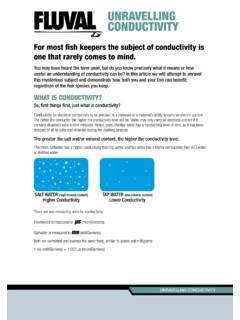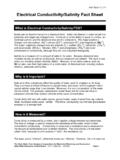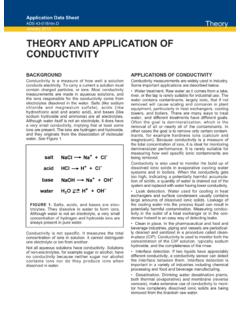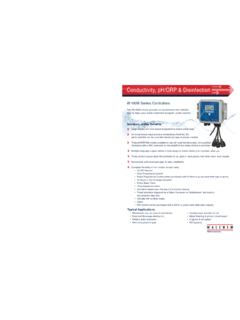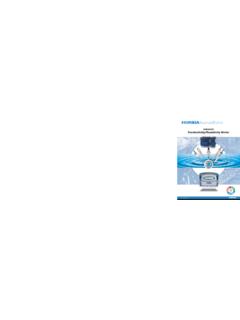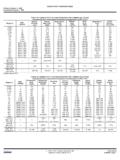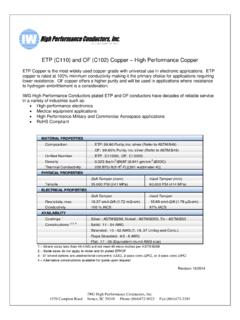Transcription of Is There an Accurate Low-Conductivity Standard …
1 29 THE INTERNATIONAL JOURNAL OF METROLOGYJULY AUGUST 2000It is suggested that an Accurate calibration be definedas a calibration within 1%-2% tolerance. This tolerancewas chosen because many instrument manufacturers tolerances fall into this range. Furthermore, the UnitedStates Pharmacopeia guidelines [1] under the USP 24 Monographs require a cell calibration within a 2%tolerance. [2] Key industries affected by such issues arepharmaceutical, biotechnology, semiconductor, andpower generation. This paper contains fresh experimentaldata, determines the accuracy of some low-conductivitystandards, and evaluates the feasibility of their launched this study in response to anincredible amount of confusion and controversy on thepart of end-users concerning high-purity conductivitycalibrations and Low-Conductivity standards .
2 The studywas performed in cooperation with an end-user of bothconductivity instrumentation and conductivity solutionstandards, Chiron Technologies. Chiron Technologies isa leading biotechnology firm based in San Diego,California. Chiron s Metrology Laboratory Supervisor,John Jacanin, provided independent verification of theRosemount laboratory methods and ensured that the data,analysis, and conclusions presented in this paper are non-biased. Similarly, Southern California Edison s laboratorywas contracted by Rosemount to perform an independentand formal confirmation of some low conductivitystandards solutions.
3 The experimental data from bothlaboratories was analyzed, and conclusions regardingboth accuracy and the magnitude of error are addition, alternative calibration methods are Standard solutions tested in this study werepurchased from common laboratory supply catalogcompanies and from specialty chemical companies. Anattempt was made to purchase Standard solutions directlyfrom the National Institute of standards and Technology(NIST); however, all of the Low-Conductivity standardswere on indefinite backorder. The NIST customer serviceperson was unable to provide an estimated availabilitydate.
4 A similar attempt to purchase NIST Low-Conductivity standards over a year ago yielded the solutions from three sources weretested in this study. Representative samples were testedat both the Rosemount Analytical laboratory and anindependent water chemistry laboratory (SouthernCalifornia Edison Co., Water Technology ResourcesLaboratory). The majority of the solutions were tested atRosemount. The SCE Lab findings were used to validatethe Rosemount findings. Due to the nature of the samplesolutions, they can only be measured once. For each Low-Conductivity solution Standard , the stated conductivityvalue and tolerance was taken off the certificate of analysisthat was affixed to its sealed containers of solution standards were placedin a constant temperature bath to adjust their temperatureto C C.
5 The containers were periodicallyshaken to ensure proper mixing and ample time wasallowed for temperature stabilization. The conductivitymeasurements were taken immediately after breaking theIs There an AccurateLow- conductivity Standard Solution?Matthew GingerellaRosemount AnalyticalUniloc DivisionJohn A. JacaninChiron Technologies Certified Low-Conductivity solutions down to 10 microsiemens/cm are readily available for the calibrationof conductivity /resistivity instrumentation. Can these standards be relied upon for Accurate and certifiedcalibrations? What are the practical tolerances of these standards ?
6 The surprising answers to thesequestions are valuable to anyone responsible for high-purity water quality. For regulated industries, theramifications of the findings could mean the difference between being in or out of compliance. 30 THE INTERNATIONAL JOURNAL OF METROLOGYJULY AUGUST 2000container s seal. The solutions were measured withcertified reference lab cells andconductivity bridges. The twolaboratories conducted tests com-pletely independent of one another,using their own reference cells andconductivity bridges, lab equipment,supplies, and quality , the precise referenceinstruments used at each of thelaboratories were of the same makeand models.
7 Both laboratories mea-sured conductivity with the BeckmanModel RC-20 conductivity Bridge( ) and Beckman A-Serieslaboratory glass conductivity stand-ard cells (about %). The totaluncertainty in the laboratorymeasurements is less than 1%.The reference bridges were calib-rated with NIST traceable resistors of tolerance. The reference cellswere calibrated per the widelyaccepted American Society of Testingand Materials (ASTM) D1125methodology, [3] using NIST traceable lab devices and glasswarefor the Standard cell calibration. Inthe ASTM D1125 method, a knownconductivity solution is freshlyprepared per a detailed chemicalrecipe and following strictprocedures.
8 The reference sensor tobe certified is placed into this knownsolution and its exact cell constant isdetermined. The certified referencecell can then be used to calibrate othertest cells in side-by-side reference cells hold theircalibration well with typical re-certification schedules of threemonths or the solutions in plastic con-tainers with wide-mouth openings,the conductivity measurement wasperformed directly in the originalcontainer after rinsing the referencecell with 18 Megohm-cm water. Forthe glass-bottled containers, thesolution Standard was transferred toa meticulously cleaned and rinsedbeaker that had been brought toconstant temperature in the samebath.
9 The conductivity measurementwas then performed in the beakerafter rinsing the reference cell withsome of the test results from each of thethree sources are presented separate-ly, below. The maximum, minimum,and mean percent errors are graphedin Figure 1 for each of the #1 Table A presents the detailedresults from testing the nominal10 S/cm Low-Conductivity standardsolutions from Source #1 that werepackaged in glass bottles. Eightsamples from three different lotswere tested. The Rosemount labFigure 1. Range of Error for Low-Conductivity # 1 All measurements at Degrees CLab readings tolerance: Less than 1%PackageLotSolution sSolution sErrorPercentSample #RosemountSCE LabIDStatedStated( S/cm)% ErrorLab( S/cm)ValueTolerance( S/cm)( S/cm) ( S/cm) ( S/cm) ( S/cm) ( S/cm) ( S/cm) ( S/cm) ( S/cm) ( S/cm) =mean =mean= There AN Accurate Low-Conductivity Standard SOLUTION?
10 MATTHEW GINGERELLA, JOHN A. JACANIN 31 THE INTERNATIONAL JOURNAL OF METROLOGYJULY AUGUST 2000tested three of the samples and determined the mean conductivity to be S/cm with a Standard deviation S/cm. The SCE lab tested five of the samples and determined the mean conductivity to be S/cm with astandard deviation of S/cm. The errors ranged between 29 to 34% with a mean of (see Figure 1).Table B presents the detailed results from testing the nominal 10 S/cm Low-Conductivity Standard solutions fromSOURCE # 1 All measurements at Degrees CLab readings tolerance: Less than 1%PackageLotSolution sSolution sErrorPercentSample #RosemountSCE LabIDStatedStated( S/cm)% ErrorLab( S/cm)ValueTolerance( S/cm)( S/cm) ( S/cm) ( S/cm) ( S/cm) =mean = #1 that were packaged in plastic containers.










